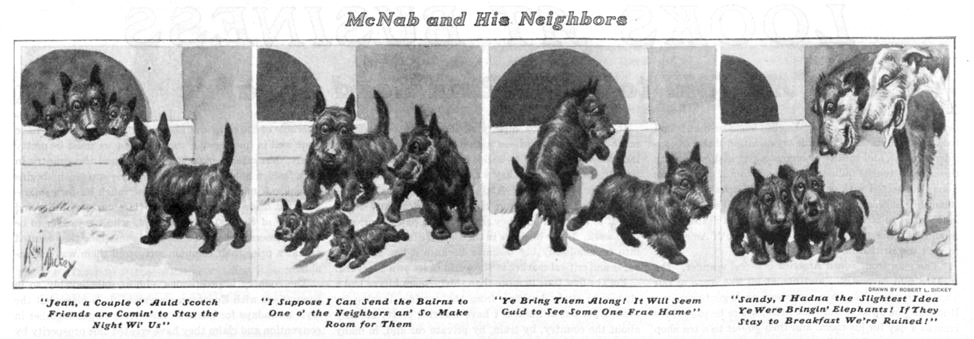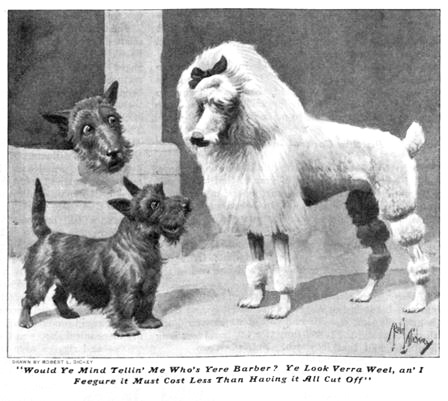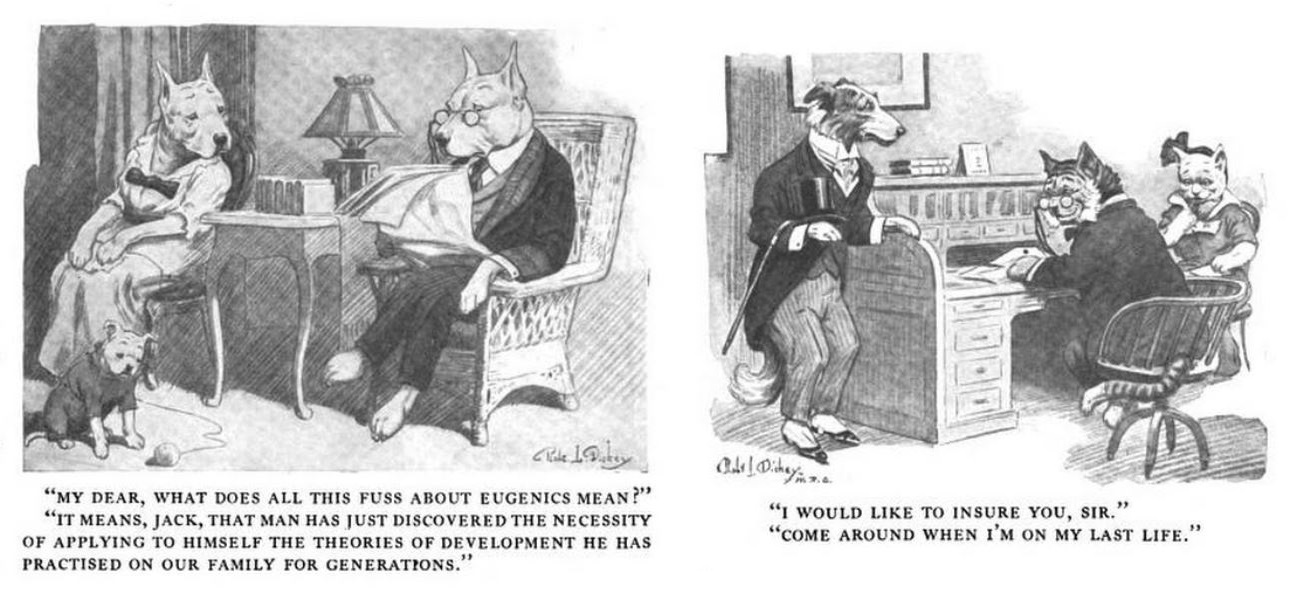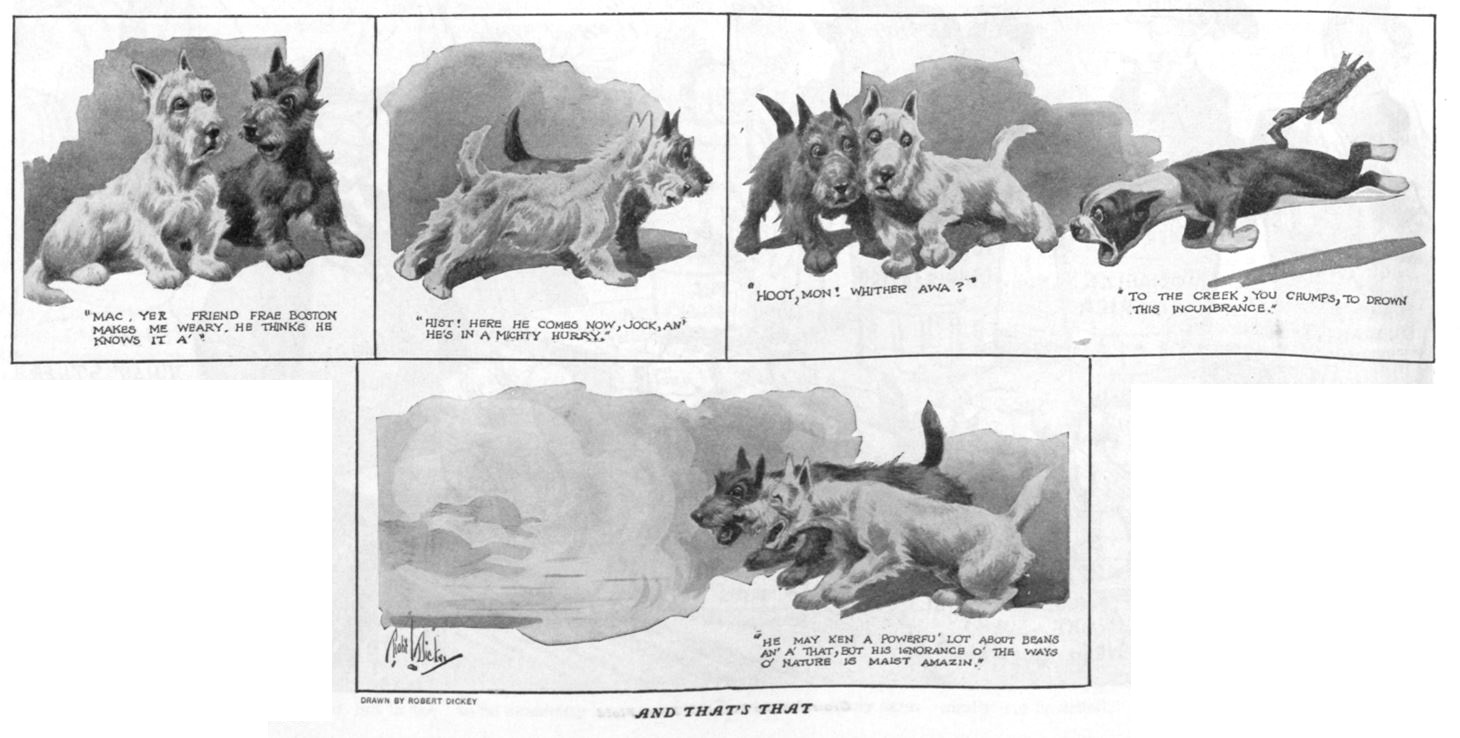A Midwesterner through and through, Robert L. Dickey displayed a peculiar commitment to thick Scottish dialect in portraying his characters Sandy and Jean McNab. The McNabs were a spousal pair of Scottish Terriers in Dickey’s comic strip, “McNab and His Neighbors” that ran in this magazine through the 1920s. Whether the McNabs were beloved because of their innate cuteness or the silliness of lines of dialogue that would nowadays have readers running for a translator app (“It will seem guid to see some one frae home”) is difficult to say. But Dickey — in spite of his decades of animal illustration that may have changed the way we see our pets — has been all but forgotten. The once-celebrated artist has nary a Wikipedia page or accessible obituary.

Before drawing adorable pooches, Dickey made his name as a horse illustrator for Chicago’s The Horse Review. As a child, he was enamored with animals, and at a young age he won first prize at the county fair for a drawing of Goldsmith Maid, a legendary mare of harness racing in the 19th century. His winnings amounted to one dollar and a ribbon, but he soon found himself taking commissions from race horse owners and local farmers from his hometown of Marshall, Michigan.

Though he sustained an enthusiasm for horse racing, Dickey’s true artistic muse became the canine. One specific canine, in fact: a white bull terrier named Chimmie Fadden. In the pages of this magazine, in 1929, Dickey proclaimed that his former pet had been a most important art teacher: “His one brindle eye and his two brindle ears could, to me and my family, express all the human emotions; admiration, adoration, adulation were all expressed in the big brown eyes, half hidden beneath the narrow lids of his breed. He could cock one brow in incredulity, and with eye, ear and tail express the utmost contempt.” Of his beloved Chimmie, Dickey also said, “He taught me all the vital things — the things that I have tried hard to get into my drawings — the expression and aliveness that are so important.”

Dickey moved to New York and began publishing comics and illustrations with Life, at the encouragement of editors John Ames Mitchell and Thomas L. Masson. In Dogs from “Life” (1920), Masson calls Dickey “perhaps the best dog artist in this country,” and he credits that success to Life’s guidance, of course. Masson writes that Mitchell advised Dickey to give his dog illustrations more realistic qualities instead of making caricatures: “Don’t make your dogs humorous. You are too good an artist to attempt that sort of thing. Make your dogs true to life — just as they are.”


If Dickey followed the Life editor’s advice, he promptly disregarded it for his work in The Saturday Evening Post. After a few tries at political cartoons, Dickey settled in with some recurring characters for the “Short Turns and Encores” section. Throughout the ’20s, in strips like “Timmie and Tatters,” “McNab and His Neighbors,” and “Mr. and Mrs. Beans,” Dickey portrayed cute dogs of various breeds with the humorous hangups and eccentricities of everyday people. With an affinity for terriers, Dickey’s strips showed the lighter side of relationships, middle-class vanity, and machismo.

Beans and Violet, Dickey’s signature Boston Terriers in “Mr. and Mrs. Beans,” were named after his own Boston Terriers that travelled with the artist any time he left New York City. Dog historian Cathy Flamholtz credits Dickey for the immense popularity of the breed in the 1920s and ’30s (in Boston Terriers: The Early Years), writing, “While the critics may have scoffed at Robert Dickey’s drawings, the public loved them! Confirmed readers of the most popular magazines fell in love with the clownish dogs seen in the pages of their favorite publications. They wanted one of these dogs and they bought ‘America’s Dog’ in large numbers. Soon, Boston Terriers were one of the most popular breeds in the country.” Flamholtz notes of Dickey’s work in comic strips, tobacco ads, and magazine covers, “The drawings reflect the charm, curiosity, mischievousness, and intelligence of the Boston Terrier. They could only have been made by someone who knew the breed so intimately.”

In spite of Dickey’s contributions to American illustration, he is scarcely remembered. His crowd-pleasing comics filled with “puppy dog eyes” and deviant hounds changed the way dogs were rendered in publication and likely altered the way people thought about their four-legged friends. His strips were printed in newspapers around the country as well as Ladies’ Home Journal, Century, and other magazines. He also illustrated the Barse edition of Black Beauty and books like Lad: A Dog and A Dog Named Chips by Albert Payson Terhune. But in his characters, Beans, Violet, and Sandy McNab, Dickey opened the door in the public imagination to the possibility of a dog expressing human faults, joys, and sorrows — and maybe even sporting a Scottish accent.






 Order a copy of The Saturday Evening Post: A Celebration of Dogs!, with full-color images by Robert L. Dickey, Norman Rockwell, and more.
Order a copy of The Saturday Evening Post: A Celebration of Dogs!, with full-color images by Robert L. Dickey, Norman Rockwell, and more. Become a Saturday Evening Post member and enjoy unlimited access. Subscribe now




Comments
Another wonderful illustrated article on a ‘forgotten’ artist that absolutely should be remembered today. You have a real gift for delving into those archives and finding incredible, enjoyable features!
I want to read the ’29 story here also. He really DID learn a lot from his own dog, Chimmie Fadden and interpreting the range of emotions dogs feel and express as much as humans. His horse illustrations are wonderful too, by the way. Thank you also for distinguishing ‘Life’ magazine from the later LIFE. Most people know don’t know about the former, which featured so many of Dickey’s works.
Love the Scottish Terriers of course, and the standard poodle pictured together. (The poodle I mentioned in your recent sleep feature was much more closely shaved, except for the 4 cuffs, tail, ears and BIG hair with the bow.) I love how he ‘humanized’ the dogs in situations, and no doubt would have enjoyed the Subaru TV ads from 2015 where they’re driving the cars, stopping at the gas station—for drinks and more. Great series.
Of ALL of these dogs though, the Boston Terriers are my favorites. I love the ones featuring Mr. and Mrs. Beans; the drawings and the humor. I miss my Boston Terrier (he had floppy ears) and always will. The bottom panel is wonderful where they talk about their shortcomings in the tail department. I’ve got to order the new book today. I know I’ll love it already.